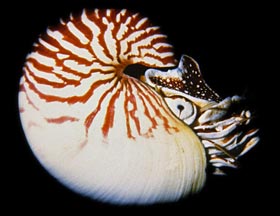Chitin (kai-tin) is the main material for 1) the exoskeleton of shrimp, crabs and lobsters, 2) the beak of squid and octopi and 3) the radula of mollusks. It is very similar in make up to glucose and similar in function to keratin (which is what makes up our hair, skin and nails).
What is the mystery of the chambered nautilus?
“Year after year beheld the silent toil
That spread his lustrous coil;
Still, as the spiral grew,
He left the past year’s dwelling for the new,
Stole with soft step its shining archway through,
Built up its idle door,
Stretched in his last-found home, and knew the old no more.”
Oliver Wendell Holmes (1804-1894)
The above is only an excerpt from the poem, “The Chambered Nautilus” by Holmes published in 1858. It only begins to hint at the marvel of this magnificent cephalopod. The chambered nautilus has become breathtaking subject matter for generations of artists and has become a commodity on the commercial trade industry.
The chambered nautilus is a squid that lives inside a shell marked with a brown and white zebra pattern. As the squid grows, the shell grows with it and creates compartments which are used as gas chambers and help the cephalopod rise or sink in the water column. The inside of the shell is lined with an iridescent pearl. In the last chamber of the shell are almost 90 tentacles and large eye peering out. Predators of the chambered nautilus include sharks, turtles, and octopus.
What makes the chambered nautilus so mysterious and sought after? Is it the mother of pearl that lines the inside of the animal’s shell? Is it that the animal represents a far off species only found tropical Indo-Pacific? Or is it that the inside compartments of the chambered nautilus each mirror its smaller and larger part exactly and therefore the animal is an example of the golden rectangle found in nature.
This harmonic progression is an illustration of Fibonacci’s sequence. This is a sequence where the first two numbers in the series are added to create the third number for a series of number that begins 0, 1, 1, 2, 3, 5, 8, 13, 21, 34 and so on forever. This proportional pattern can be seen all over in nature: flower petals, pine cones, and even galaxies. Below is an illustration of the proportion as it relates to the chambered nautilus.
Image (c) top – seasky.org, bottom – http://2muchfun.info
Do you have another interesting question? E-mail info@beachchairscientist.com and let us know what you always ponder while digging your toes in the sand!
Reference Squid
I would love to share this wonderful squid dissection video from Paul Dewiler, Instructor of Marine Science at the San Diego Mesa College. The video was inspired by his overview during his Ultimate Squid Dissection workshop at the National Marine Educators Associations 2010 conference in Gaitlinburg, TN. He states that the purpose of the video is to, “illustrate the squid’s external and internal anatomical structures so that teachers are confident and able to lead and assist their students in dissecting this species in the classroom”. As someone that has struggled with and watched other struggle with the dissection of a squid I am excited to share this wonderful resource. Thank you, Paul!









What people are saying …